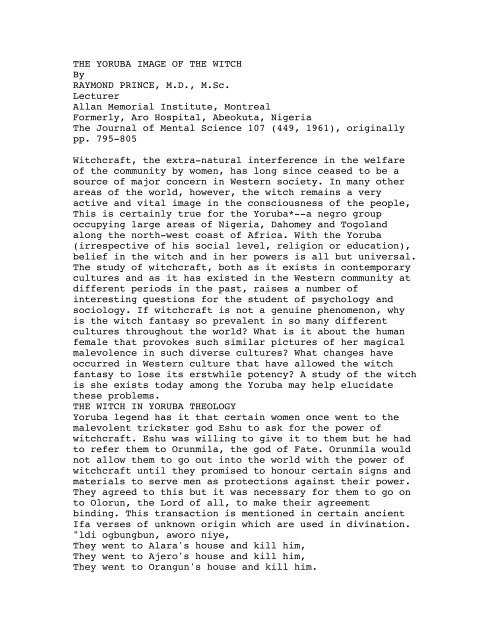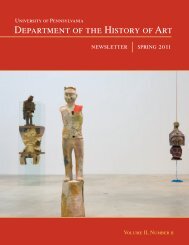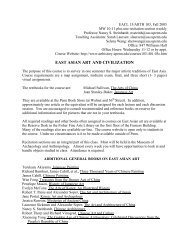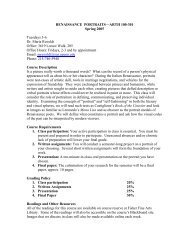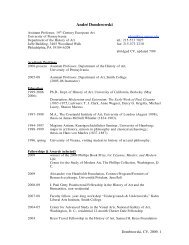THE YORUBA IMAGE OF THE WITCH By RAYMOND PRINCE, M.D. ...
THE YORUBA IMAGE OF THE WITCH By RAYMOND PRINCE, M.D. ...
THE YORUBA IMAGE OF THE WITCH By RAYMOND PRINCE, M.D. ...
- No tags were found...
You also want an ePaper? Increase the reach of your titles
YUMPU automatically turns print PDFs into web optimized ePapers that Google loves.
<strong>THE</strong> <strong>YORUBA</strong> <strong>IMAGE</strong> <strong>OF</strong> <strong>THE</strong> <strong>WITCH</strong><strong>By</strong><strong>RAYMOND</strong> <strong>PRINCE</strong>, M.D., M.Sc.LecturerAllan Memorial Institute, MontrealFormerly, Aro Hospital, Abeokuta, NigeriaThe Journal of Mental Science 107 (449, 1961), originallypp. 795-805Witchcraft, the extra-natural interference in the welfareof the community by women, has long since ceased to be asource of major concern in Western society. In many otherareas of the world, however, the witch remains a veryactive and vital image in the consciousness of the people,This is certainly true for the Yoruba*--a negro groupoccupying large areas of Nigeria, Dahomey and Togolandalong the north-west coast of Africa. With the Yoruba(irrespective of his social level, religion or education),belief in the witch and in her powers is all but universal.The study of witchcraft, both as it exists in contemporarycultures and as it has existed in the Western community atdifferent periods in the past, raises a number ofinteresting questions for the student of psychology andsociology. If witchcraft is not a genuine phenomenon, whyis the witch fantasy so prevalent in so many differentcultures throughout the world? What is it about the humanfemale that provokes such similar pictures of her magicalmalevolence in such diverse cultures? What changes haveoccurred in Western culture that have allowed the witchfantasy to lose its erstwhile potency? A study of the witchis she exists today among the Yoruba may help elucidatethese problems.<strong>THE</strong> <strong>WITCH</strong> IN <strong>YORUBA</strong> <strong>THE</strong>OLOGYYoruba legend has it that certain women once went to themalevolent trickster god Eshu to ask for the power ofwitchcraft. Eshu was willing to give it to them but he hadto refer them to Orunmila, the god of Fate. Orunmila wouldnot allow them to go out into the world with the power ofwitchcraft until they promised to honour certain signs andmaterials to serve men as protections against their power.They agreed to this but it was necessary for them to go onto Olorun, the Lord of all, to make their agreementbinding. This transaction is mentioned in certain ancientIfa verses of unknown origin which are used in divination."ldi ogbungbun, aworo niye,They went to Alara's house and kill him,They went to Ajero's house and kill him,They went to Orangun's house and kill him.
You pluck the Okro of EjiwoYou eat the Camwood of AiloranYou kill the stammering water of Owu.When Eshu came, you left for a place in the sky and itreceived you not,Then you went to Orunmila and when you got there, yougreeted him and he askedyou where you were going.Then you said you were going into the world to be killingpeople and to be debarringtheir progress.It is a forbidden act to eat soap.Then Orunmila said that he would not allow the gates to beopened unto you,unless you go to the Almighty God, when you got there, youexplain yourselves to him.Then the almighty God said:'Spittle once out of the mouth, will not come back to themouth again,The grass that the elephants tread will never rise again,Therefore you must not change your agreementAnd anybody with this sign on should be honoured'."(Ifa Odu, Idi Meji)<strong>THE</strong> NATURE <strong>OF</strong> <strong>THE</strong> <strong>WITCH</strong>It is clear then that in Yorubaland, witchcraft is afeminine art and has its power from Eshu, the trickstergod, and was sanctioned, if somewhat reluctantly, byOrunmila (lfa) the god of Fate, and by Olorun, the Lord ofall. This power is generally attributed to older women, butyoung women or even girls can sometimes be involved.According to some informants, witchcraft power is a kind ofimmaterial substance which may be kept in a calabash hiddenin a hole in the wall of the witch's house, or in a hollowtree. The power itself may be lodged in the roots of a treeor even in a young child (age 1 to 8 years). In the lattercase the witchcraft power will not harm the child but, onthe contrary, will protect the child from other witches asthe child is serving one of them as a refuge. The red tailfeatherof the parrot is used as a sign of witchcraftpower, and may be placed in the calabash or in the treecontaining the witchcraft power. (I have been unable tofind out the origin of this use of the red feather or whyit should come to have this association with the witch.)Other informants regard the power as a more concrete
substance which is present in the woman's abdomen. As oneman said: "I have seen two women vomit it out. It was likea stone or a hard ball of something. They were not iskilled the witches after that." Witchcraft seems generallyto be held as a desirable skill because of the great powerit provides; however, there is also the idea that thespirit of the witch after death becomes a restless anddisconsolate ghost who wanders about the world in adistraught state. The power is usually passed from motherto daughter, but it may also be bestowed as a gift, or maybe purchased. When passed from one person to the other itis often given mixed with certain foods. It is sometimesheld that a woman cannot die possessing witchcraft powerbut must pass it on to someone before her death; in fact,she will not be able to die unless she does so.Perhaps some actual comments by Yoruba informants wouldhelp clarify these aspects."Witchcraft power is like a breeze, you can't see it but ithas effect. A woman can't die possessing it-when she dies,she vomits out the invisible witchcraft and it passes toher daughter.""A wornan can buy witchcraft power or may, as well, inheritit from another person. This mostly depends on the interestor love the witchcraft woman has in the person that isgoing to possess it. Sonic people when they suffer toomuch, seek for this power. In this case she has to buy it.But it is very necessary, and matter of must, to give thiswitchcraft power to somebody before she should die. In thiscase, if she could not get anybody either to buy it or togive it out as a gift to her friend outside, or to have adaughter she loved that can inherit it, she has to take itto an Iroko tree that is very young. This will become aspirit in the tree. Other witches will be coming to thistree to have their meetings. It is such trees thatherbalists carry their sacrifices to in case they have apatient that is seriously sick.""Through many informants I believe that a woman may buy,inherit or be presented with this power. This is not givendirectly. It can be given through foods such as baked beans(Akara), Kola, Porridge, red Yam (Esuru) and many othernative foods. When this is taken the power will start togrow, until when the person will start to fly in thenight."<strong>THE</strong> POWERS <strong>OF</strong> <strong>THE</strong> <strong>WITCH</strong>Witches are considered to have great power-"They are therulers of the world, they get their power from God who gavethem permission to kill. They have no mercy. They can doanything." They are said sometimes to have favourites whom
they protect and make wealthy but these positive aspectsare not emphasized-they are mostly spoken of in connectionwith their malevolence. The Yoruba word for witch is Ajeand would appear to be a [' somewhat contraction of "iyaje" meaning "mother eat". The word Aje is avoided as muchas possible or at least spoken in a whisper (for fear ofattracting the witch's attention or offending her). Theexpressions "Agbalagba" witchcraft (old people), "awon iya"(our mothers) or "Awon eni toni aiye" (those who a calabashrule the world) being substituted. A witch's malignancy maybe turned upon a man for almost any reason-for some slightimpoliteness, or because he accuses her of being a witch,or because he is getting too high in the world or often forno reason "just because they are evil women".One of the commonest fantasies about the powers of thewitch is that she can transform her "heart-soul" (Okan)into a bird or animal. This occurs at night and herphysical body remains in a deep sleep while her transformedheart-soul moves abroad. A woman who sleeps on her backwith her mouth open and arms outstretched is probably awitch. She cannot be awakened while her heart-soul isabroad and if someone captures the bird or animal intowhich her soul has been transformed she will not be able towake up; if the creature is killed the witch will die. Mostwitches transform themselves into night birds of sometype…these have been variously described to me as "a whitebird with a long red beak and red claws" or "a brown birdlike a bush fowl with a long red beak" Alternatively theymay transform themselves into owls, cats, rats or bats, thecommon feature being that these creatures are all active bynight, for it is believed that witchcraft is a nocturnalthing, the witches being most active between 12 and 3 a.m.in the realms of dream and nightmare. If the witch'sactivities are brought into the light of day, they losetheir potency, e.g., by confession. It is believed that thewitch bird perches by night in a tree close to the victim'shouse. An owl perched in a tree near a man's house willcause considerable alarm to the householder. The actualmanner in which the witch bird damages her victim isobscure but I have been told that it pecks its victim'shead or neck and sucks out his blood. There is a saying,"Ale ke lana, omo ku loni" (the witch bird chirpedyesterday, the child dies today).Witches are considered to take part in some obscurenocturnal orgies (ajo) for which one member of the witchparty must supply a human child. A patient told me, "Mywife is a high-tempered woman. If anything happened shewould curse everyone, sometimes if she fought with someone,
if it was settled whether she was wrong or right she wouldargue for three days. If I corrected her she would alwaysargue. She has a twisted foot. One day she pointed at aplace in time farm and said there had been a great feastthere last night but I had not heard of it. When I askedher more about it she grew annoyed. After that I was afraidand began to suspect she was a witch.<strong>By</strong> drinking the life blood of numerous victims, the witchis thought to be able to prolong her own life, and it isfor this reason that old people are suspected of beingwitches. A pregnant woman will avoid visiting an old womanduring her pregnancy and the birth of a baby will be kept asecret from a suspected old woman. In some areas the deathof a young person or child is considered unnatural and allsuch deaths are attributed to the work of witches.In addition to old age, other factors may lead the peopleto regard a woman as a witch-a woman with a beard, adomineering or cantankerous woman or a woman who engages inodd behaviour. One girl told me, "An old woman in our townwho used to go about collecting old broken bottles andother things and packing them in her room for no purposewas thought to be a witch, but no one said anything openlyfor fear of what she might do." One of the most commondeeds attributed to witches is interference withreproduction. Impotence is common among Yoruba males and itis the prevalent idea that this is the work of witches. Awitch is said to be capable of taking the penis of a manand having intercourse, using it with the man's wife orsome other woman. The witch will then return the man'spenis but it will be altered in some way and may not beable to function. The woman who is visited in this way maybecome barren. It is a not uncommon dream for a man to seesomeone come to him and tamper with his penis or testicles.A woman will dream of someone having intercourse with herthevisitor may be either in the form of a man or of awoman with a penis. All this is considered to be the workof witches. Witches are also thought to control themenstrual flow of women. They can make it stop or flowexcessively. They may obstruct the expulsion of the childfrom the womb. There is some obscure fundamentalrelationship between witchcraft and menstrual blood. Themenstruating woman and the witch both have power to rendermagic and the native doctor's medicines powerless. On onerecent occasion in the town of A. the women of the town hadrisen in revolt against the payment of certain taxes whichthey native considered to be unfair. Their power was sogreat that they forced the ruling chief of the town to
etire to the provinces for a year. They camped in hordesin front of the chief's palace singing and causing adisturbance. When police were sent to disperse them thewomen brandished their menstruation cloths. This caused thepolice to take to their heels, for it is believed that if aman is struck by a woman's menstrual cloth he will have badfortune for the rest of his days.In addition to these two most emphasized propensities ofthe witch (i.e., to cause wasting diseases or death throughsucking the blood and eating the spirit of the victim andto interfere with his sexuality), she may cause psychiatricdisturbances, to be described subsequently, and all mannerof other misfortunes and accidents. I will give just twofurther examples. A witch may cause to come down over alorry-driver's eyes so that he cannot see where he is goingand will drive into the ditch (Incidentally, many lorrydrivers'cabs are so filled with charms and "medicine"hanging from the windscreen that they can scarcely seeout!) I have also been told that when a witch closes hereyes she can see everywhere and can observe all that ishappening. It is said of a powerful political leader, whowas recently killed in a motor accident, that at one timehe kept an old woman in his house who used to tell him whatto do and where to go and "when the time would be safe".Later he gave up taking her advice and he was destroyed bythe "medicine" of his political opponents. (The fatalaccident took place near Ijebu Ode which is a town renownedfor its "powerful medicines", particularly cursing, andwhere many of his opponents lived.)DEFENCES AGAINST <strong>WITCH</strong>CRAFTThere are three general methods by which the Yoruba maydefend himself against witches: (1) with the help of nativemedicine usually as instructed by the native doctor, (2)through membership in certain cults, and (3) throughorganizing witch hunts and using trial by ordeal, thoughthis last has been frowned upon, at least during theBritish regime in Nigeria. I will say a few words abouteach in turn.The Yoruba native doctor sees a good deal of his work asprotecting his patients from witchcraft, againstmalevolently-used words (i.e. curse, incan-tation andinvocation) and against various other types of homoeopathicand contagious magics. Witchcraft is usually the territoryof malignant women, while magic words and practices are theterritory of the warlock. It is true that many nativedoctors have some conception of the physical causation ofdisease, e.g. that disease may come from eating incorrectfoods-"cocoa doesn't grow well on all types of earth"; that
"small, small bugs or worms cause tuberculouslymphadenitis"; that "epilepsy is the result of a lizard inthe belly". Still the elements of witchcraft and sorceryare much emphasized. As one doctor said to me, "If you havetwo patients each with the same disease to the same degreeand you give both the same herbs, one gets better but theother may not. This is because the witches are involved inthe latter." It would appear that recently (though I haveno idea when this attitude began) the relationship betweenthe witches and the native doctors has altered. In formertimes, they were always at loggerheads but the nativedoctors' medicines were usually the more powerful and couldovercome the effects of witchcraft. Now, however, thewitches have become so powerful that the native doctor hasjoined forces with the witches and works in co-operationwith them. For example, if a patient comes to the nativedoctor with an illness that the doctor divines or diagnosesas having an ruling element of witchcraft in it, he willask the patient to provide a sacrifice to the witches.After the witches are thus appeased the native doctor'smedicines will be potent. I was unable to find out too muchabout the native doctor's dealings with the witches becauseof their covert nature. My visits to native doctors almostalways took place amid a throng of people, my interpreterand I seated on folding wooden chairs with the doctor in asmall room in his mud hut, a great press of people--men,women and children--squeezing through the narrow windowsand pushing in at the door. I soon learned that under suchcircumstances the one subject that could not be discussedwas witchcraft. I do not know whether this was becausethere might have been some witches in the audience whowould not like their secrets revealed or whether most ofthe people were unaware of the co-operation between thenative doctor and the witch, a subject then that would bepainful to the native doctor. At any rate it seems highlyclear that in former days the role of the native doctor wasto divine who the witch was who was causing the patient'sillness, point her out and have her banished or killed.Often methods of ordeal were used to discover the witch. Imight mention some of the types of medicines used by thenative doctor as defences against witchcraft. On oneoccasion I watched a doctor make a medicine which he saidwas to protect against eye diseases caused by witches. In apiece of white cloth he placed a disembowelled chickenstill covered with feathers together with some otherobjects which looked like pieces of white soap. He bowedhis head and quietly recited an incantation over thepreparation. He then wrapped up these materials in the
white cloth which then formed a round ball about 8 inchesin diameter, and tied it around with many windings of blackand white thread (the threads being placed side by side).This bundle was to be suspended from the ceiling of thepatient's house. The native doctor had a similar bundlehanging from his own ceiling. The same native doctor was a"specialist" in treating mental illness* and was also usinga very effective infusion of the roots of the plantRauwolfia vomitorum (which contains many of the samealkaloids as R. serpentina, including reserpine). Inaddition to this tranquillizer each of his patients hadevery day to smear himself with black soap to protect himfrom the witches. Also he had growing in the middle of hiscompound a special tree which would not allow witch birdsto perch in it. It is probable that the use of the soap andof the fowl with the feathers is related to the passagefrom the Ifa verses which I quoted earlier. The use ofthese substances prevents the witches from consuming thespirits of the patients through something akin tohomoeopathic magic. The formula appears to be, "No one eatsblack soap or fowls with the feathers on, I have a fowlwith feathers on as a defence and am covered with soap,therefore no one, not even a witch, will eat me."To turn to the cults which may protect a man from thewitches: one of the most important of these is the Geledecult which has recently been very well described by Mr. U.Beier (1958). It is a very popular cult among the Egbadothe Yoruba who occupy the south-western portions ofYorubaland. The Gelede are dancers, all male except for theleader. They wear brilliantly painted wooden masks overtheir heads and dress up as women with large breasts andprotruding buttocks. I would like to quote from Beier'sarticle passages which describe the function of the cultand the motives for becoming a member."The purpose of the Gelede dance is to 'placate thewitches'. This is what every Geledc dancer says . . . Themen say: Gelede is 'the secret of women'. We the men aremerely their slaves. We dance to appease 'our mothers'. Thewitches, they say, can kill in the dark, and there is noprotection from their power. 'because God has already giventhem permission to kill, confess their God does not mindkilling-because for every man who dies he can make a newone.' "One Gelede dancer said: 'As I have already got threechildren, there is no reason why I should not die. Nothingprevents me from dying tomorrow. But as I am a member ofthe Gelede society, the witches will spare me.'"Another dancer expressed it as follows: 'God gave the
world to the witches. They have woman was permission tokill. In the olden days they did a great deal of harm toour fathers. But our fathers thought for a long time untilthey found a way to placate them and win their favour, thusthe Gelede society was started. Fear of death made us jointhis society. Because the witches cannot harm anyone insidethe society'."The dance may occur once a year or perhaps oftenerdepending upon the leader. The main portion of the dancetakes place at night though some of the masqueraders maydance the next day for general amusement. The dance ishighly organized with different members of the cultappearing in special order and singers who accompany thedrumming with songs sacred to the society. Part of one ofthe songs addressed to the "great mothers" is ofconsiderable interest and is as follows:"All-powerful mother, mother of the nightbirdMother who kills animals without strikingMy mother kills quickly without a cryTo prick our memory suddenlyQuickly as the woodpecker picks the tree on the farmThe woodpecker who hammers the tree while words rush forthfrom his mouth,Great mother with whom we dare not cohabitGreat mother whose body we dare not seeMother of secret beautiesMother who empties the cupWho speaks out with the voice of a man,Large, very large mother on the top of the iroko tree,Mother who climbs high and looks down on the earthMother who kills her husband yet pities him."The masks used in the dance are ingeniously carved and havea great variety of subjects. Above the carved heads areserpents, women in exhibitionistic poses, mothers andchildren, or witch birds pecking into the head. (I havealso seen one of a woman sitting at a sewing machine andanother of aeroplanes with propellers at both ends!)It seems clear, that the feminine costume representsincorporation of and identification with the threateningmothers--a kind of ritualized transvestitism as a defenceagainst the devouring and castrating mother.The witch hunt is another method of defence againstwitches. As I have said, at the present time the witchesare too powerful in Yorubaland to be openly opposed by thenative doctors (seine of whom actually dance under theGelede masks). Occasionally, however, a group of divinersand ordeal men may band together and go from village tovillage to search out the witches. Such a band was the
Atinga, a group which began its activities in the northernGold Coast, spread down to the coastal areas of the GoldCoast and through Togoland and Dahomey to southern Nigeria.The Atinga sought the assistance of the heads of thevillages who called their people together. The Atingaleaders began to beat the drums and dance in the circle ofcollected villagers. During the dance one of the Atingabecame possessed, claimed to receive the ability toprophesy and pick out witches. The accused women wereforced to bring out their witching apparatus-calabashes,familiars, red feathers, etc. --and confess their evildeeds. If a woman refused to confess she had to undergo anordeal. She had to bring a fowl, some gin and some money.The gin was poured out as a libation, and the fowl had itsthroat half cut so that it would run about for a while,then collapse. If the chicken collapsed with its breastupright, the woman was acquitted. If the ordeal wasunfavourable the woman could try a second time providingshe paid more money. Most women confessed, but a few werebeaten to death. The movement was quashed by the BritishGovernment in 1951.Many Yoruba recall vividly the Atinga hunts. According toone informant, the king of town A. did not invite theAtinga to practise their arts in his town because he saidthat many of the pillars of the community were witches.Another Yoruba, a schizophrenic patient, said that hisbrother, who was a policeman, had been instrumental inbringing the Atinga into his home town. He said thatshortly afterwards his brother was killed under unusualcircum-stances and he himself "ran mad". He attributed bothof these misfortunes to his brother's meddling in theaffairs of the town witches.<strong>THE</strong> <strong>WITCH</strong> AND PSYCHIATRIC DISTURBANCEPatients suffering psychiatric disturbances frequentlyconsider their symptoms to be the result of witchcraft.Many schizophrenic patients, for example, accuse theirmothers of being witches. Indeed the sight of the psychoticson, apathetic and with downcast eyes, walking down theroad behind his mother renders the fantasy of theconsumption of the son's spirit by the mother not toounrealistic.The patient may implicate the witches in his illness for anumber of reasons. Perhaps the commonest indications are tobe found in dreams--dreams of drowning are almost alwaysinterpreted in this way; dreams of intercourse with unknownpersons or of having ones genitals tampered with or theclassical "nightmare" dream experience (pressure on thechest, terror and suffocation) are other examples.
Secondly, the native doctor, as a result of his divination,may inform time patient that he is being troubled by awitch. It may also happen that the patient developssymptoms during the time the patient is having somedifficulties with a woman. He may then of course attributethese symptoms to the witchcraft of his female opponent. Anillustrative example might be helpful here. P.F. was a 17-year-old Yoruba male admitted to Are Hospital, Abeokuta, inMarch, 1959, with the complaints that he had been behavingirrationally (fighting with other students in his schoolfor no reason and running away from school), he wasrambling and abstract in his conversation and unable to dohis school work. The patient's father, an executive in aGovernment Department, had two wives, the patient being theonly child of the senior wife. The junior wife had twochildren. All the children were attending the same schooland whereas the patient was a good student, the son of thejunior wife was a poor student and the father proposed totake the poor student out of school but send the patient oninto higher education. This was a source of intenseannoyance to the junior wife. The patient describes theonset and course of his illness as follows:"At the end of 1957, 1 finished school and went to Lagos tospend the holiday with father. On reaching Lagos I met mybrother 0., who failed the examination, and my sister andwe were very loving to ourselves. Seeing how co-operativewe three were, their mother would always call them andadvise them to sever their connection from me. I had onebed where we both slept and studied. I woke up one nightabout I a.m. and found 0. gone. I intended to put my penunder the pillow where I met a butchered red-headed lizard.The intestines were removed and inside the stomach wereseven needles and some ashes. Since that time I haven'tbeen able to study any book or even stay in the schoolhostel-there are certain commanding instincts in me thatpush me to do certain things that I know to be very bad. Ialso have nightmares all the time that my father's secondwife is beating me."Because of these symptoms he was expelled from school andtaken to several native doctors, but to no avail. Thenative doctors attributed his illness to the witchcraft ofthe second wife. In this instance certain medicine (i.e.the lizard and needles) was used but this is the exceptionrather than the rule with witches.With the psychotic patient, the content of hishallucinatory experience may convince him that witches areattacking him. For example a 20-year-old Yoruba student
described the onset of his psychosis as follows:"1 was sitting at my table in my room late at night. I hada strange feeling and looked up and saw a woman standinglooking in at my window. Then a white bird flew from thewoman into my mouth and lodged in my throat so that Icouldn't speak and felt choked."This student was subsequently admitted to hospital in adisturbed state; he heard the voice of the holy spirit andexpressed the idea that a witch and the Holy spirit werefighting inside of him.A third example is that of M.N., a 35-year-old singleYoruba cocoa farmer convicted of decapitating a woman witha matchet. He said that his trouble had started in 1956 andthat he was being troubled by witchcraft day and night. Thewitches were talking to him continually saying such thingsas "It's done, he's killed: we have killed him now, now wewill kill his brother", etc. The witches had started totrouble him after he had refused to attend the Cherubim andSeraphim church. "After that I would hear bats' voices inmy ears and I would be confused. They troubled me at nightin dream, they would come both man and woman and pull at mytesticles and penis. One night they cut my penis right offbut I prayed and it was restored . .. In the morning Icould see all the veins were coming out and it was notnormal." It was clear that this patient had the idea thatthe woman he killed was the witch that was tormenting him.The delusion of being a witch also occurs; however, thewoman who makes such a confession is generally not regardedas being delusional or psychotic, the idea being, as itwere, culturally syntonic. There is the belief in someparts of Yorubaland that a witch cannot die until she hasconfessed her evil deeds, and in conformity with this ideacertain old women (probably suffering senile psychoses) maybe seen wandering around the streets telling of the peoplethey have killed and the children they have eaten. Such oldwomen are generally driven from their homes and may bestoned in the streets. None of these patients were broughtto the psychiatric clinic. On one occasion, however, apsychotic woman who had believed she was a witch and hadkilled her young daughter was referred from the court. Herconfession written a few hours after the killing read asfollows:between the night of Tuesday and Wednesday the 20th and21st of August, my mates in witchcrafts came to my houseand instructed me to kill my daughter 0. and I killed herthat very night with a stick which is still in my room, andbefore this done I held her two legs swinged her around myhead and knocked her on the floor three times. All these
eing done in the night. After the death I used matchet tocut her two legs and I threw the matchet in a brook. I alsokilled a cat and packed both the cat and my daughter in abasket."DISCUSSIONThe idea associated with the name of Melanie Klein (1935,1940) that the infant passes through a stage in which hedivides his mother into two entities, one good and theother bad, has merited considerable contemporary interest.Under normal circumstances this propensity seems to occurbetween the ages of three months and one year and resolvesitself in the so-called "depressive position" when thechild is capable of grasping that the good mother and thebad mother are in reality one. This splitting of an objectinto good and bad titles may also be observed in adultpsychotics. For example a housewife suffering from paranoidschizophrenia was transferred to me from a ratheraggressive female psychiatrist. The patient expressed theidea that there were really two of her formerpsychiatrists, one who was tender and friendly, the one whowas brusque and short-tempered. She said they both lookedthe same but that she felt that one was real while theother was an impostor. It would seem that by the adult, aperson is recognized to be an entity largely on the basisof external and objective cues, e.g. on the basis ofexternal appearance, gestures, voice, etc., whereas by theinfant (and the schizophrenic noted above) the test ofidentity is "similarity of feeling toward" so that a personthat aroused fear or a wave of depressic hostility had tobe a different entity from the one that aroused pleasure.To return to the idea of the witch, it is an attractivehypothesis that the Yoruba witch represents the collectiveimage of the bad mother in a people who have not yetattained the depressive position in their emotionaldevelopment. I do not think we would be distorting theYoruba concept too much to think of witchcraft asrepresenting all the bad aspects of the mother or thefemale. It is true that not all women are thought to bewitches, but all women are potentially witches and they arelinked to witchcraft in some way through the common bond ofmenstruation. The fact that the witches are called "ourmothers" and the fact that many schizophrenics say theirmothers are witches seems to lend support to the idea.It may also be noted that depressions are rare among theYoruba. Paranoid thinking is common but the profound selfcastigatingmelancholia so commonly seen in thecontemporary Western man is very uncommon. I can remember
only one case of this type and the patient was highlyWesternized-reared in a literate Christian home, welleducated herself, and who had lived in England for severalyears. Could this mean that the Yoruba as a culture has notreached the "depressive position"?It is also of interest that the Yoruba mother tends to beidealized to a considerable extent and the relationshipbetween mother and son is much more significant thanbetween husband and wife. The latter relationship is almostdistant-there seems to be no romantic element, wives beingof value as status symbols and as bearers of childrenrather than for warmth of relationship. There seems to besome evidence then that with the Yoruba, their emotionaldevelopment is arrested to the extent that intenserelationships exist primarily between mother and child andthat even in this relationship the mother tends to be onthe one hand revered unrealistically and over-valued and onthe other hand feared as a destructive entity in thebackground with all her witchly attributes. The fusion ofthese two images has not yet occurred, the depressiveposition not yet reached, the Yoruba has not yet been ableto release himself from his mother so that little progresshas been made towards relationship between husband andwife.To turn for a moment to time interesting question-whatchanges have occurred in Western culture that have allowedthe witch fantasy to lose its erstwhile potency? I wouldlike to draw attention to three books published in acluster about the beginning of the 17th century: ReginaldScot's Discoverie of Witchcraft (1584), Cervantes' DonQuixote (1605) and Burton's Anatomy o Melancholy (1621).The first two of these books mark the beginning of the endof two rather extraordinary attitudes towards the femalesex in Europe.* Scot was one of the first to ridicule theidea of the witch and question the reality of her abilitiesto fly, transform herself into animals, etc. Cervantes'book was a satire on the knight and his ideal lady andmarked the beginning of the fading of that complementarymedieval female image--the knight's lady--which had existedfor some 300 years alongside the image of the witch. Thethird of these books marks the high point as it were in theRenaissance preoccupation with the problems of melancholia,depression and death. These problems were great interest toElizabethan dramatists and poets and there are numerousrepresentations and paintings of the Danse Macabre and theDance of Death. Can we take this interest in melancholia asan indication that there was in fact a wave of depressionspreading over Europe between the 14th and 17th centuries?
The literary and artistic interest in depression and deathis generally attributed to the plague and poverty producedby the Hundred Years War. Is it possible that thedepression resulting from the attainment of time cultural"depressive position" was the primary event and that timeBlack Death was in part a symptom of this wave ofdepression? We could look upon the Renaissance then as aleap forward in reality testing with a concomitant releaseof human vitality accompanying the European "workingthrough" of its depressive position.ACKNOWLEDGMENTSI would like to thank Dr. S. Franklin, Chief MedicalAdviser of the Western Region ofNigeria, for permission to use clinical material in thispaper.REFERENCESfilER, U., Odu, Journal of Yoruba and Related Studies,1958, 6, 50.Di ROUGEMENT, D., Love in the Western World, 1940. NewYork.KLEIN, M., mt. J. Psycho-Anal., 1935, 16, 145.Idem, ibid., 1940, 21, 125.LAMBO, T. A., .1. Ment. Sd., 1955, 101, 239.Idem, Brit. Med. J., 1956, 2, 1388.<strong>PRINCE</strong>, R. H., J. Ment Sc,., 1960a, 106, 559.1km, Canad. Psych. Ass. J., 1960b, 5, 65.1km, Amer. J. Psychiat., 1960c, 118, 147.


